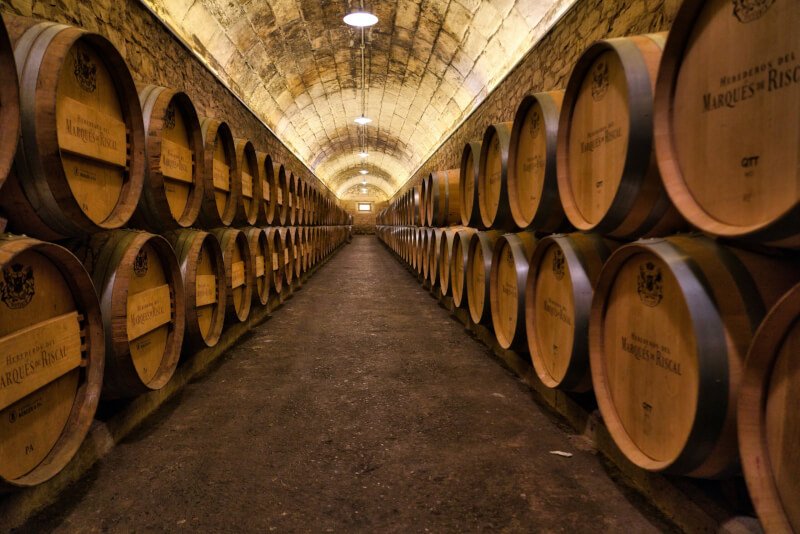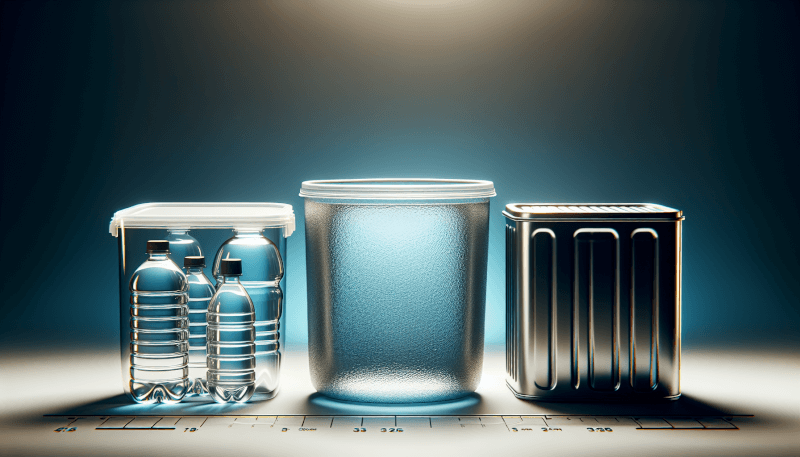Are you tired of constantly searching for the perfect food storage solution? Look no further! In this article, we will explore the pros and cons of three popular options: plastic, glass, and metal containers. Whether you’re concerned about durability, safety, or practicality, we’ve got you covered. So, put on your detective hat and let’s unravel the mystery of the best food storage containers together!

Plastic Containers
Plastic containers have become a staple in our kitchens and pantries due to their numerous advantages. First and foremost, they are lightweight, making them easy to handle and transport. This feature is particularly beneficial when it comes to packed lunches or meal prepping for the week. Additionally, plastic containers are highly durable and resistant to breakage, making them an excellent choice for those with bustling households or for those who frequently travel with their food. Moreover, plastic containers are often microwave-safe, allowing you to conveniently reheat leftovers without having to transfer them to another dish. Lastly, plastic containers are typically more affordable than their glass or metal counterparts, which makes them an attractive option for budget-conscious individuals.
However, it’s essential to consider the potential drawbacks of plastic containers as well. One significant disadvantage is the possibility of chemical leaching. Certain types of plastic, such as those containing BPA, can release harmful substances into your food when exposed to heat or acidic ingredients. To mitigate this risk, it’s crucial to opt for BPA-free plastic containers or those labeled as food-safe. Additionally, plastic containers may stain or retain odors over time, which can be challenging to eliminate completely. To prevent this, thorough and regular cleaning is necessary.
When it comes to types of plastic containers, there is a wide variety to choose from. From lightweight disposable containers perfect for picnics or takeout to heavy-duty freezer-safe options, the options are endless. Some plastic containers even come with divided compartments, perfect for keeping different food items separate and preventing unwanted mixing. To select the right plastic container for your needs, consider factors such as size, lid design, compartmentalization, and whether it is microwave and dishwasher-safe.
Glass Containers
Glass containers have recently gained popularity as a sustainable and eco-friendly alternative to plastic and metal containers. One significant advantage of glass containers is their non-porous nature, which means they won’t absorb food odors and flavors over time. This makes them perfect for storing a wide range of foods without worry. Glass containers are also highly resistant to staining, ensuring that your containers stay clean and aesthetically pleasing for longer periods. Moreover, glass containers are microwave-safe, allowing for convenient reheating, and their transparency makes it easy to identify the contents without having to open them.
However, glass containers do have their disadvantages. The most obvious one is their fragility. Unlike plastic or metal, glass can break easily if mishandled or dropped. This fragility can be a concern, especially in households with children or in situations where containers may go through rough handling during transportation. Furthermore, glass containers tend to be heavier than their plastic counterparts, which can be inconvenient when packing lunches or carrying multiple containers at once.
When it comes to types of glass containers, there are various options available. From stackable containers with snap-on lids to those with airtight silicone seals, the choice depends on your specific needs and preferences. Some glass containers also come in different shapes and sizes, making them suitable for a wide range of food storage requirements. To choose the right glass container, consider factors such as lid design, sealing capabilities, stackability, and whether it is dishwasher-safe.
Metal Containers
While not as widely used for food storage as plastic or glass, metal containers offer their own unique advantages. One significant advantage of metal containers is their durability. Metal containers are resistant to breakage, making them an excellent option for those who require sturdy and long-lasting storage solutions. Additionally, metal containers are often lightweight, which is beneficial for portability and transportation purposes. Another advantage is that metal containers are generally oven-safe, allowing you to easily transition from storage to cooking without having to transfer your food to a different dish.
Despite their advantages, metal containers do come with a few drawbacks. One of the main concerns is the possibility of metal leaching into your food, particularly with acidic or highly seasoned dishes. To minimize this risk, it’s crucial to opt for high-quality food-grade metal containers or those lined with a protective coating. Metal containers can also be susceptible to rust over time, especially if not properly cared for. Regular cleaning and drying are important to maintain their longevity and prevent rust formation.
When it comes to types of metal containers, stainless steel is the most commonly used material due to its durability and resistance to corrosion. Stainless steel containers are available in various sizes and shapes, offering versatility for different storage needs. Some metal containers also come with airtight lids or silicone seals, ensuring that your food remains fresh and protected. To select the right metal container, consider factors such as size, lid design, durability, oven-safeness, and whether it is dishwasher-safe.
Environmental Impact
When considering food storage containers, it’s essential to take into account their impact on the environment. Plastic, glass, and metal containers each have their own environmental implications.
Plastic containers can be a cause for concern due to their contribution to plastic waste and potential harm to marine life. While many plastic containers can be recycled, it’s important to note that not all types of plastic are recyclable, and recycling rates vary depending on your location. Additionally, the production of plastic containers often involves the use of fossil fuels and chemicals, which can have negative impacts on the environment. It’s crucial to choose plastic containers made from recyclable materials and strive to reduce overall plastic consumption.
Glass containers are often considered a more sustainable option as they are made from natural materials and can be recycled indefinitely without losing quality. Glass recycling rates are generally higher than plastic recycling rates, making it an environmentally friendly choice. However, it’s important to note that the transportation of glass containers can contribute to greenhouse gas emissions due to their weight and fragility. Choosing locally made glass containers can help reduce the environmental impact associated with transportation.
Metal containers, like glass containers, have the advantage of being recyclable without losing their quality. Metal recycling rates can vary depending on the specific material, but overall, metals are highly recyclable. The extraction and production of metals, however, can have environmental impacts, particularly in terms of energy consumption and greenhouse gas emissions. Opting for recycled metal containers or those made from more sustainable sources can help mitigate these impacts.

Safety Considerations
Safety is a crucial consideration when it comes to food storage containers, as they come into direct contact with our food. Here, we will discuss the safety aspects of plastic, glass, and metal containers.
Plastic containers have faced ongoing scrutiny due to concerns about chemical leaching, particularly with the use of certain types of plastics. Bisphenol A (BPA), for example, has been linked to potential health risks. To ensure safety, it’s essential to choose plastic containers labeled as BPA-free or specifically designated as food-safe. It’s also important to avoid exposing plastic containers to high temperatures or acidic ingredients, as this can increase the likelihood of chemical leaching.
Glass containers are considered generally safe for food storage. Unlike plastic, glass does not contain potentially harmful chemicals that can leach into your food. However, it’s important to handle glass containers with care, as they can break and cause injuries. When using glass containers, be mindful of the potential risks associated with fragility.
Metal containers, particularly those made from food-grade materials such as stainless steel, are generally considered safe for food storage. However, there may be concerns about metal leaching into the food, especially with acidic or highly seasoned dishes. To minimize this risk, it’s important to choose high-quality metal containers that are food-grade and lined with a protective coating.
Durability and Longevity
When choosing food storage containers, it’s essential to consider their durability and longevity, as this can impact their overall value and sustainability.
Plastic containers are known for their durability and resistance to breakage, making them a reliable choice for long-term use. However, over time, plastic containers can become scratched, stained, or warped, which can affect their functionality and aesthetics. Regular cleaning and care can help prolong their lifespan.
Glass containers are highly durable and resistant to scratching, staining, and warping, ensuring their longevity. Unlike plastic containers, glass containers do not deteriorate over time, and their transparency remains intact, allowing for easy identification of the contents. With proper care, glass containers can last for many years, providing excellent value for money.
Metal containers, particularly those made from stainless steel, are renowned for their durability and resistance to breakage. They can withstand the test of time, remaining functional and intact for extended periods. However, it’s important to note that metal containers may be susceptible to rust if not properly cleaned and dried. Regular maintenance is necessary to ensure their longevity.

Versatility and Functionality
The versatility and functionality of food storage containers are essential aspects to consider, as they determine how well the containers meet your specific needs.
Plastic containers come in a range of shapes, sizes, and designs, making them highly versatile and suitable for various purposes. From stackable storage solutions to those with divided compartments, plastic containers offer flexibility in organizing and storing different food items. They are an excellent choice for those who value convenience and customization.
Glass containers are known for their multi-functionality. Besides being used for food storage, glass containers can seamlessly transition to serving dishes, allowing you to display your culinary creations with elegance. Additionally, glass containers are freezer-safe, ensuring that your food remains fresh for longer periods. Their ability to withstand high temperatures also makes them suitable for baking or cooking.
Metal containers, particularly those made from stainless steel, provide great versatility in terms of their uses. They can efficiently store a wide variety of foods and are oven-safe, allowing for seamless transitions between storage and cooking. Due to their durability, metal containers can also be used for outdoor activities such as camping or picnicking, providing reliable storage on the go.
Aesthetics
The aesthetics of food storage containers may not be a primary concern for everyone, but having visually pleasing containers can enhance the overall experience.
Plastic containers come in a variety of colors and designs, allowing for personalization and aesthetic appeal. Whether you prefer bold and vibrant colors or sleek and minimalist designs, there are plastic containers to suit every style and taste. However, it’s worth noting that plastic containers may become discolored or faded over time, particularly if exposed to high heat or certain foods.
Glass containers are renowned for their timeless and elegant appearance. The transparency of glass allows you to showcase your culinary creations effortlessly. Whether you prefer a classic and clean look or a more decorative design, glass containers can add a touch of sophistication to your kitchen and dining area. Furthermore, the aesthetics of glass containers remain intact over time, as they are resistant to fading or discoloration.
Metal containers, particularly those made from stainless steel, often have a sleek and modern appearance. The clean lines and polished finish of stainless steel containers can add a contemporary touch to your kitchen. Additionally, the durability and resistance to wear and tear of metal containers ensure that they maintain their aesthetic appeal for years to come.

Price Range
Price is undoubtedly an essential factor to consider when choosing food storage containers, as it can greatly influence your decision-making process.
Plastic containers are generally the most affordable option when compared to glass and metal. Their widespread availability and mass production contribute to their lower price range. Plastic containers come in varying price points, depending on the brand, size, and features. This affordability makes them an attractive option for those on a budget or those who require a large quantity of containers.
Glass containers, on the other hand, tend to be more expensive than plastic containers. The cost of glass containers can vary depending on factors such as brand, size, and lid design. The higher price is often attributed to the quality and longevity of glass containers, as well as their eco-friendly reputation. Investing in glass containers can be a worthwhile choice for those looking for a sustainable and long-lasting option.
Metal containers, particularly those made from stainless steel, are typically priced higher than both plastic and glass containers. The cost of metal containers can be attributed to the durability and versatility they offer. The high-quality materials used and their resistance to wear and tear contribute to their higher price range. However, it’s important to consider that metal containers can provide excellent value for money due to their long lifespan.
Ease of Use and Cleaning
The ease of use and cleaning of food storage containers can greatly impact their practicality and efficiency in everyday life.
Plastic containers are known for their lightweight nature, making them easy to handle and transport. Their flexibility allows for easy stacking and storage. When it comes to cleaning, most plastic containers are dishwasher-safe, ensuring convenience and time-saving. However, it’s important to note that some plastic containers may become discolored or warped with prolonged dishwasher use. Hand-washing with warm soapy water is an alternative option.
Glass containers are relatively straightforward to use and clean. Their transparency allows for easy identification of the contents, saving time and effort. Glass containers are also generally dishwasher-safe, making cleaning a breeze. However, due to their weight and fragility, extra care is required when handling and stacking glass containers to avoid breakage.
Metal containers, particularly those made from stainless steel, are generally easy to use and clean. They are lightweight and often come with tight-fitting lids, ensuring secure storage and easy transportation. Most metal containers are dishwasher-safe, simplifying the cleaning process. However, it’s important to note that some metal containers may require hand-washing or specific care instructions to maintain their appearance and performance.
In conclusion, the choice between plastic, glass, and metal containers ultimately depends on your individual needs, preferences, and values. Plastic containers offer convenience and affordability but come with concerns about chemical leaching. Glass containers provide an elegant and sustainable option but can be fragile and more expensive. Metal containers offer durability and versatility, but there may be concerns about potential metal leaching. Considering factors such as environmental impact, safety considerations, durability, versatility, aesthetics, price range, and ease of use can help you make an informed decision and find the perfect food storage containers for your kitchen.



